Soot Blowers
Soot blowers are becoming less and less important in the Petrochemical and Refinery industry during modern times. The reason for this is that generally, any component of the flue gases that can foul the tubes can also foul the air. So, as clean air requirements continue to get more stringent, the resulting cleaner fuels are less likely to foul the tubes. However, since many areas of the world continue to burn fuel oils that are likely to require soot blowing, the following guidelines are presented to demonstrate their application.
Soot blowers as used in these furnaces are usually one of the following types:
Retractable Soot Blower: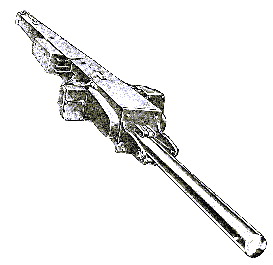 |
The retractable blower gets it's name from the fact that the element that does the cleaning is retracted out of the hot gas stream when it is not in use. Since it has less nozzles than a fixed rotary blower, it can produce a better cleaning velocity for the same steam pressure. This type blower is used for the higher temperature and dirtier fuel applications. |
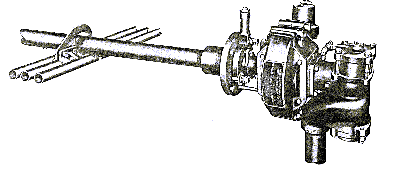 |
The rotary blower is in a fixed position and since the element is supported by the hangers at different points, the element requires less material than the retractable blower. This blower costs less than the retractable, but requires a greater volume of steam. This type blower is used for the lower temperature and cleaner fuel applications. |
Oil - ash corrosion becomes more severe with increased temperatures and the nature of the corrosive agent. Above 1300°F where V2O5 or other mixtures sinter and melt, corrosion is intensified. The significant part that sodium plays in forming low melting complex compounds indicates that not only vanadium, but also sodium is highly undesirable in residual fuel oil as it affects fire side deposits.
Sootblower Recommendations:Under normal operating conditions, we recommend sootblower selection as follows:
| A. | Below 100 ppm vanadium or 25 ppm sodium or 2% sulphur in the fuel oil: |
| Rotary sootblower to 1800°F gas temperature. Retractable sootblower above 1800°F. | |
| B. | 100 to 200 ppm vanadium or 25 ppm sodium or 2% sulphur in the fuel oil: |
| Rotary sootblower to 1300°F gas temperature. Retractable sootblower above 1300°F. | |
| C. | Above 200 ppm vanadium or contents in excess of 25 ppm sodium or 2% sulphur in the fuel oil: |
| Rotary sootblower to 1050°F gas temperature. Retractable sootblower above 1050°F. |
Under control conditions other factors may be used to modify sootblower selection.
Air/Fuel Ratio:Down to a ratio of 20/1 the corrosion rate is not much affected at constant temperature.
Below this point corrosion rates will be reduced even to a low figure at the theoretically correct ratio.
The lower corrosion at the lower ratios is explained by the formation of V2O3 or V2O4 rather than V2O5. These lower oxides of vanadium have a higher melting points than V2O5 and tend to be carried through the system as harmless dust.
The following tables may be used to estimate the effective cleaning radii.
Rotary Sootblower:Fuel : Cleaning radius based on use of # 6 Fuel Oil.
Gas temperatures dictate element materials as listed below:
Up to 900 °F - Carbon Steel
900 °F to 1500 °F - Chrome Alloy
1500 °F to 1800 °F - Hi Alloy
| Maximum Element Length of 10', Normal Tube Size Up To 3 1/2" | ||||||||
| Tube Arrg't | Studs | Fins | Sootblower Spacing(See Figure 1 to 4) | |||||
| A | B | C | D | E | F | |||
| Square | Up to 3/4" | 5'-0" | 2'-6" | 2'-6" | 2'-6" | 5'-0" | 3'-0" | |
| Over 3/4" | 4'-0" | 2'-0" | 2'-0" | 2'-0" | 4'-0" | 2'-6" | ||
| 3/inch | 5'-0" | 2'-6" | 2'-6" | 2'-6" | 5'-0" | 3'-0" | ||
| 5 to 7/inch | 4'-0" | 2'-0" | 2'-0" | 2'-0" | 4'-0" | 2'-6" | ||
| Triangular | Up to 3/4" | 4'-0" | 2'-0" | 2'-0" | 2'-0" | 4'-0" | 2'-6" | |
| Over 3/4" | 3'-0" | 1'-6" | 1'-6" | 1'-6" | 3'-0" | 2'-0" | ||
| 3/inch | 4'-0" | 2'-0" | 2'-0" | 2'-0" | 4'-0" | 2'-6" | ||
| 5 to 7/inch | 3'-0" | 1'-6" | 1'-6" | 1'-6" | 3'-0" | 2'-0" | ||
| Maximum Element Length of 20', Normal Tube Size Up To 4" And Over | ||||||||
| Tube Arrg't | Studs | Fins | Sootblower Spacing(See Figure 1 to 4) | |||||
| A | B | C | D | E | F | |||
| Square | Up to 3/4" | 6'-0" | 3'-0" | 3'-0" | 3'-0" | 6'-0" | 3'-6" | |
| Over 3/4" | 5'-0" | 2'-6" | 2'-6" | 2'-6" | 5'-0" | 3'-0" | ||
| 3/inch | 6'-0" | 3'-0" | 3'-0" | 3'-0" | 6'-0" | 3'-6" | ||
| 5 to 7/inch | 5'-0" | 2'-6" | 2'-6" | 2'-6" | 5'-0" | 3'-0" | ||
| Triangular | Up to 3/4" | 5'-0" | 2'-6" | 2'-6" | 2'-6" | 5'-0" | 3'-0" | |
| Over 3/4" | 5'-0" | 2'-6" | 2'-6" | 2'-6" | 4'-0" | 2'-6" | ||
| 3/inch | 5'-0" | 2'-6" | 2'-6" | 2'-6" | 5'-0" | 3'-0" | ||
| 5 to 7/inch | 4'-0" | 2'-0" | 2'-0" | 2'-0" | 4'-0" | 2'-6" | ||
| Maximum Element Length of 10', Normal Tube Size Up To 3 1/2" | ||||||
| Tube Arrg't | Sootblower Spacing(See Figure 1 to 4) | |||||
| A | B | C | D | E | F | |
| Square Bare Tubes | 10' | 5' | 5' | 4' | 9' | 5' |
| Triangular Bare Tubes | 8' | 4' | 4' | 3' | 7' | 4' |
| Maximum Element Length of 20', Normal Tube Size Up To 4" And Over | ||||||
| Tube Arrg't | Sootblower Spacing(See Figure 1 to 4) | |||||
| A | B | C | D | E | F | |
| Square Bare Tubes | 12' | 6' | 6' | 4' | 9' | 5' |
| Triangular Bare Tubes | 10' | 5' | 5' | 4' | 9' | 5' |
Fuel : Cleaning radius based on use of # 6 Fuel Oil.
| Normal Tube Size Up To 3 1/2" | ||||||||
| Tube Arrg't | Studs | Fins | Sootblower Spacing(See Figure 1 to 4) | |||||
| A | B | C | D | E | F | |||
| Square | Up to 3/4" | 7'-0" | 3'-6" | 3'-6" | 3'-6" | 7'-6" | 4'-0" | |
| Over 3/4" | 6'-0" | 3'-0" | 3'-0" | 3'-0" | 6'-6" | 3'-6" | ||
| 3/inch | 7'-0" | 3'-6" | 3'-6" | 3'-6" | 7'-6" | 4'-0" | ||
| 5 to 7/inch | 6'-0" | 3'-0" | 3'-0" | 3'-0" | 6'-6" | 3'-6" | ||
| Triangular | Up to 3/4" | 6'-0" | 3'-0" | 3'-0" | 3'-0" | 6'-6" | 3'-6" | |
| Over 3/4" | 5'-0" | 2'-6" | 2'-6" | 2'-6" | 5'-6" | 3'-0" | ||
| 3/inch | 6'-0" | 3'-0" | 3'-0" | 3'-0" | 6'-6" | 3'-6" | ||
| 5 to 7/inch | 5'-0" | 2'-6" | 2'-6" | 2'-6" | 5'-6" | 3'-0" | ||
| Normal Tube Size Up To 4" And Over | ||||||||
| Tube Arrg't | Studs | Fins | Sootblower Spacing(See Figure 1 to 4) | |||||
| A | B | C | D | E | F | |||
| Square | Up to 3/4" | 8'-0" | 4'-0" | 4'-0" | 4'-0" | 8'-6" | 4'-6" | |
| Over 3/4" | 7'-0" | 3'-6" | 3'-6" | 3'-6" | 7'-6" | 4'-0" | ||
| 3/inch | 8'-0" | 4'-0" | 4'-0" | 4'-0" | 8'-6" | 4'-6" | ||
| 5 to 7/inch | 7'-0" | 3'-6" | 3'-6" | 3'-6" | 7'-6" | 4'-0" | ||
| Triangular | Up to 3/4" | 7'-0" | 3'-6" | 3'-6" | 3'-6" | 7'-6" | 4'-0" | |
| Over 3/4" | 6'-0" | 3'-0" | 3'-0" | 3'-0" | 6'-6" | 3'-6" | ||
| 3/inch | 7'-0" | 3'-6" | 3'-6" | 3'-6" | 7'-6" | 4'-0" | ||
| 5 to 7/inch | 6'-0" | 3'-0" | 3'-0" | 3'-0" | 6'-6" | 3'-6" | ||
Figure 1 : Square Pitch Finned Tubes : Longitudinal Arrangement
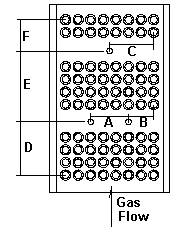
Figure 2 : Triangular Pitch Finned Tubes : Longitudinal Arrangement
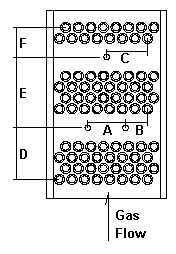
Figure 3 : Square Pitch Finned Tubes : Perpendicular Arrangement
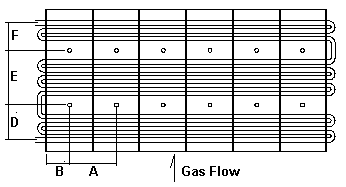
Figure 4 : Triangular Pitch Finned Tubes : Perpendicular Arrangement
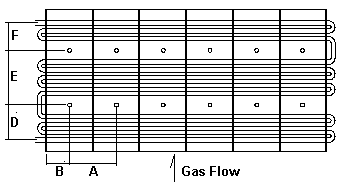
Recommended Minimum Blowing Pressures
| Rotary Sootblower | |
| Element length up to 10' maximum, tube sizes up to 3 1/2" OD | |
| Square Pitch | 150 psig |
| Triangular Pitch | 200 psig |
| Rotary Sootblower | |
| Element length up to 10' up to 20' maximum, tube sizes 4" OD and over | |
| Square Pitch | 175 psig |
| Triangular Pitch | 225 psig |
| Retractable Sootblower | |
| Square Pitch | 100 psig |
| Triangular Pitch | 150 psig |
Disclaimer:
The formulas and correlations presented herein are all in the public domain and are to be used only as a learning tool. Note that any product, process, or technology in this document may be the subject of other intellectual property rights reserved by sponsors or contributors to this site. This publication is provided as is, without any warranty of any kind, either expressed or implied, including, but not limited to, the implied warranties of fitness for a particular purpose, or non-infringement.
The formulas, correlations, and methods presented herein should not be considered as being recommended by or used by the sponsors of this site. The purpose of this site is educational and the methods may or may not be suitable for actual design of equipment. Only a fired heater design engineer is qualified to decide if a calculation or procedure is correct for an application.